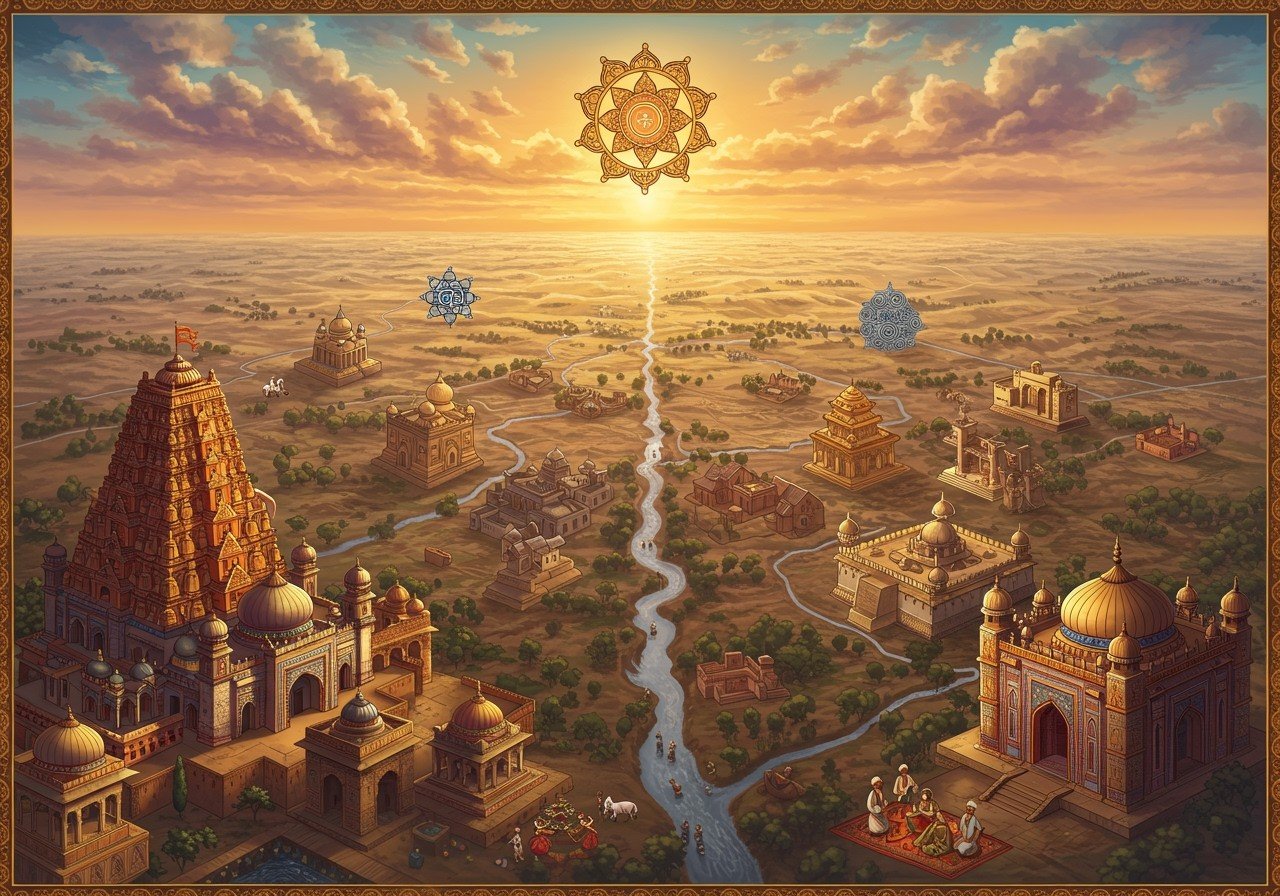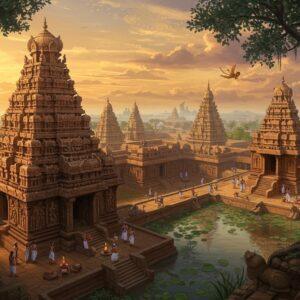
The Deccan Plateau, a vast expanse across western and southern India, whispers tales of ancient kingdoms, spiritual journeys, and cultural confluences. Imagine a land where history comes alive, where the echoes of Mauryan chariots mingle with the hymns of ancient temples. This is the Deccan Plateau, a region that has witnessed the rise and fall of empires, the intertwining of faiths, and the flourishing of art and architecture. From the Mauryas (4th-2nd century BCE) and Guptas (4th-6th century CE) vying for its mineral wealth to the British Raj, this land has been a coveted prize. Even today, standing amidst the architectural marvels of the Chalukyas, Rashtrakutas, or Vijayanagara Empire, one can sense the profound spiritual and cultural impact of this region.
Hinduism’s Embrace: Temples, Languages, and Arts
Hinduism, deeply rooted in the Deccan Plateau, has profoundly shaped its cultural identity. The magnificent temples at Hampi and Ellora, for instance, stand as testaments to the artistic genius and deep faith of the Chalukyas and Vijayanagara empires. These architectural wonders aren’t merely structures of stone; they are living embodiments of devotion, reverberating with centuries of prayers and rituals. The impact of Hinduism extends beyond grand temples, weaving itself into the fabric of daily life. From vibrant festivals like Diwali and Ugadi, filled with light and joy, to the classical dance forms and intricate crafts, the influence is undeniable. Even the flourishing of Kannada and Telugu literature owes much to the patronage of Hindu rulers.
For all your puja needs, explore the divine collection at Poojn.in. We offer a wide variety of authentic puja items, delivered right to your doorstep.
A Confluence of Faiths: Buddhism, Jainism, and Islam
The Deccan Plateau’s spiritual landscape is not a monolithic entity but a vibrant mosaic of faiths. Buddhism and Jainism, finding fertile ground during the Mauryan era and beyond, left an indelible mark on the region. The Ajanta Caves, with their breathtaking murals depicting the life of Buddha, stand as a testament to the spread of Buddhism under Emperor Ashoka. Jainism, with its emphasis on non-violence and spiritual liberation, contributed exquisite temples like those at Shravanabelagola, each a masterpiece of intricate carvings. The arrival of Islam, through trade and conquest, added another layer to this rich tapestry. The Bahmani and Deccan Sultanates introduced Persian-influenced art and architecture, leaving behind magnificent mosques and palaces that speak of a glorious past. This intermingling of faiths fostered a spirit of tolerance and understanding, a hallmark of Deccan culture.
Cultural Crossroads: A Fusion of Traditions
The Deccan Plateau, a bustling hub of trade and migration, has always been a crucible of cultural exchange. Like the vibrant threads of a handloom saree, diverse traditions have interwoven to create a unique cultural fabric. This syncretism is beautifully captured in the Indo-Islamic architecture, a harmonious blend of diverse styles. Sufi and Bhakti traditions, emphasizing love and devotion, further bridged the gap between communities. The flow of goods and ideas along ancient trade routes enriched regional cuisines, music, and crafts. The Deccan identity, therefore, is not a singular entity but a kaleidoscope of influences, a testament to the region’s ability to embrace diversity and create something truly special.
Celebrate the rich traditions of the Deccan with authentic puja items from Poojn.in. Find everything you need for a truly blessed celebration.
Embracing the Deccan’s Legacy
The Deccan Plateau is more than just a geographical region; it’s a living embodiment of India’s rich cultural heritage. Every ancient ruin, every vibrant festival, every unique custom whispers stories of a land where diversity is not merely tolerated but celebrated. The Deccan’s legacy reminds us that unity can be found amidst differences, that strength lies in embracing our shared humanity. It is a legacy that continues to inspire, teaching us the importance of coexistence, respect, and creativity. Let us cherish this heritage, ensuring that the spirit of harmony and mutual respect continues to thrive for generations to come.
FAQs: Exploring the Deccan’s Rich Tapestry
How has Hinduism influenced Deccan culture? Hinduism’s influence on Deccan culture is profound and pervasive. From the majestic temples of Hampi and Ellora to the vibrant celebrations of Diwali and Ugadi, Hindu traditions are deeply embedded in the region’s cultural fabric. Art, architecture, literature, and even daily rituals bear the unmistakable mark of Hindu beliefs and practices.
What roles have other religions played in shaping the Deccan Plateau? Buddhism and Jainism, with their emphasis on spiritual enlightenment and non-violence, have contributed significantly to the region’s spiritual landscape. Islam, arriving through trade and conquest, brought new artistic and architectural styles, enriching the cultural mix. This confluence of faiths created an environment of tolerance and mutual respect.
What is cultural syncretism, and how is it reflected in the Deccan Plateau? Cultural syncretism is the beautiful fusion of diverse traditions, a process vividly exemplified in the Deccan. It’s the seamless blend of Hindu and Islamic elements in architecture, the shared spiritual vocabulary of Sufi and Bhakti traditions, and the fusion of culinary practices, creating a truly unique cultural tapestry. It reflects a history of interaction and mutual influence between different groups.
How did cultural exchanges shape the Deccan Plateau? The Deccan Plateau, located at the crossroads of ancient trade routes, was a melting pot of cultures. The exchange of goods, ideas, and artistic styles led to a dynamic interplay of traditions. This constant flow of influences shaped everything from regional cuisines and musical forms to religious practices and architectural designs.
What is the Deccan Plateau’s significance in religious history? The Deccan Plateau holds a unique place in religious history as a meeting point for various faiths. This convergence led to the development of distinctive traditions, architectural styles, and artistic expressions. The region stands as a testament to the power of religious and cultural exchange.
What role did trade play in the cultural convergence of the Deccan Plateau? Trade was the lifeblood of cultural exchange in the Deccan. Traders brought not only goods but also ideas, artistic influences, and religious beliefs from far-off lands. This exchange fostered a vibrant cultural milieu, contributing to the region’s rich and diverse heritage.
How does architecture reflect religious convergence in the Deccan? The architecture of the Deccan is a powerful symbol of religious convergence. Buildings often blend elements from different traditions, such as Hindu, Islamic, and local styles. Temples, mosques, and forts display a mix of architectural features, showcasing the region’s history of cultural exchange and adaptation. For example, you might see Islamic arches incorporated into a predominantly Hindu temple design, demonstrating a harmonious blend of styles.
Experience the spiritual heart of India. Find authentic puja thalis and more at Poojn.in. We have everything you need for your puja, from diyas to dhotis.

